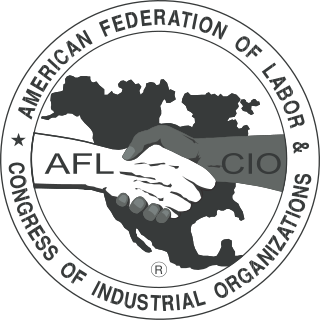Related Research Articles

The American Federation of Labor and Congress of Industrial Organizations (AFL-CIO) is a national trade union center that is the largest federation of unions in the United States. It is made up of 60 national and international unions, together representing more than 12 million active and retired workers. The AFL-CIO engages in substantial political spending and activism, typically in support of progressive and pro-labor policies.

The American Federation of Labor was a national federation of labor unions in the United States that continues today as the AFL–CIO. It was founded in Columbus, Ohio, in 1886 by an alliance of craft unions eager to provide mutual support and disappointed in the Knights of Labor. Samuel Gompers was elected the full-time president at its founding convention and was re-elected every year except one until his death in 1924. He became the major spokesperson for the union movement.

The nature and power of organized labor in the United States is the outcome of historical tensions among counter-acting forces involving workplace rights, wages, working hours, political expression, labor laws, and other working conditions. Organized unions and their umbrella labor federations such as the AFL–CIO and citywide federations have competed, evolved, merged, and split against a backdrop of changing values and priorities, and periodic federal government intervention.

John Joseph Sweeney was an American labor leader who served as president of the AFL–CIO from 1995 to 2009.

William George Meany was an American labor union leader for 57 years. He was the key figure in the creation of the AFL–CIO and served as the AFL–CIO's first president, from 1955 to 1979.

The Strategic Organizing Center (SOC), formerly known as the Change to Win Federation (CtW), is a coalition of North American labor unions originally formed in 2005 as an alternative to the AFL–CIO. The coalition is associated with strong advocacy of the organizing model. The coalition currently consists of Service Employees International Union (SEIU), the United Farm Workers (UFW), and the Communications Workers of America (CWA), the latter of which is affiliated with both the SOC and the AFL–CIO.
A directly affiliated local union (DALU) or federal labor union is a US labor union that belongs to the American Federation of Labor and Congress of Industrial Organizations (AFL–CIO) but is not a national union and is not entitled to the same rights and privileges within the Federation as national affiliates.
Thomas Reilly Donahue Jr. was an American trade union leader who served as Secretary-Treasurer of the American Federation of Labor and Congress of Industrial Organizations from 1979 to 1995, interim president for several months in 1995, and was President Emeritus from 1996 until his death. He was considered one of the most influential leaders of the post-World War II American trade union movement.
The Trades and Labor Congress of Canada was a Canada-wide central federation of trade unions from 1886 to 1956. It was founded at the initiative of the Toronto Trades and Labour Council and the Knights of Labor. It was the third attempt at a national labour federation to be formed in Canada: it succeeded the Canadian Labour Union which existed from 1873 to 1877 and the Canadian Labour Congress which held only one conference in 1881.

Matthew Woll was president of the International Photo-Engravers Union of North America from 1906 to 1929, an American Federation of Labor (AFL) vice president from 1919 to 1955 and an AFL-CIO vice president from 1955 to 1956.

Massachusetts AFL–CIO is the Massachusetts state affiliate of the American Federation of Labor–Congress of Industrial Organizations (AFL–CIO). It was founded in 1958.

The Seafarers International Union or SIU is an organization of 12 autonomous labor unions of mariners, fishermen and boatmen working aboard vessels flagged in the United States or Canada. Michael Sacco was its president from 1988 until 2023. The organization has an estimated 35,498 members and is the largest maritime labor organization in the United States. Organizers founded the union on October 14, 1938. The Seafarers International Union arose from a charter issued to the Sailors Union of the Pacific by the American Federation of Labor as a foil against loss of jobs to the Congress of Industrial Organizations (CIO) and its Communist Party-aligned faction.
The Steel Workers Organizing Committee (SWOC) was one of two precursor labor organizations to the United Steelworkers. It was formed by the CIO on June 7, 1936. It disbanded in 1942 to become the United Steel Workers of America. The Steel Labor was the official paper of SWOC.

The Department for Professional Employees, AFL–CIO (DPE) is a semi-autonomous "trade" department of the AFL–CIO, and serves as an advocate for professional workers within the federation, and before legislative bodies, the press and the public.
The AFL–CIO Organizing Institute is a unit within the Organizing and Field Services Department of the American Federation of Labor and Congress of Industrial Organizations. Founded in 1989, the OI serves as the primary training body for most organizers in the AFL–CIO and its member unions.
The United Public Workers of America (1946–1952) was an American labor union representing federal, state, county, and local government employees. The union challenged the constitutionality of the Hatch Act of 1939, which prohibited federal executive branch employees from engaging in politics. In United Public Workers of America v. Mitchell, 330 U.S. 75 (1947), the Supreme Court of the United States upheld the Hatch Act, finding that its infringement on the Constitutional rights was outweighed by the need to end political corruption. The union's leadership was Communist, and in a famous purge the union was ejected from its parent trade union federation, the Congress of Industrial Organizations, in 1950.

The Congress of Industrial Organizations (CIO) was a federation of unions that organized workers in industrial unions in the United States and Canada from 1935 to 1955. Originally created in 1935 as a committee within the American Federation of Labor (AFL) by John L. Lewis, a leader of the United Mine Workers (UMW), and called the Committee for Industrial Organization. Its name was changed in 1938 when it broke away from the AFL. It focused on organizing unskilled workers, who had been ignored by most of the AFL unions.

The Building and Construction Trades Department, commonly known as North America's Building Trades Unions (NABTU), is a trade department of the American Federation of Labor and Congress of Industrial Organizations (AFL–CIO) with 14 affiliated labor unions in the building trades. It was originally founded by the American Federation of Labor in 1907.

The Indiana AFL–CIO is the Indiana state affiliate of the American Federation of Labor and Congress of Industrial Organizations (AFL–CIO), the largest national trade union center in the United States. It was established by a merger between the state affiliates of American Federation of Labor and the Congress of Industrial Organizations in 1955. The roughly 400 local affiliates collectively represent approximately 300,000 active and retired workers.
References
- ↑ Loftus, Joseph (December 8, 1955). "Industrial unit of labor set up". New York Times.
- 1 2 3 4 5 6 7 8 9 Samuel, Howard (1985). Statement of the Industrial Union Department, AFL-CIO. Washington DC: AFL-CIO.
- 1 2 Weinstock, Deborah; Failey, Tara (2014). "THE LABOR MOVEMENT'S ROLE IN GAINING FEDERAL SAFETY AND HEALTH STANDARDS TO PROTECT AMERICA'S WORKERS". New Solutions. 24 (3).